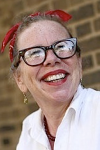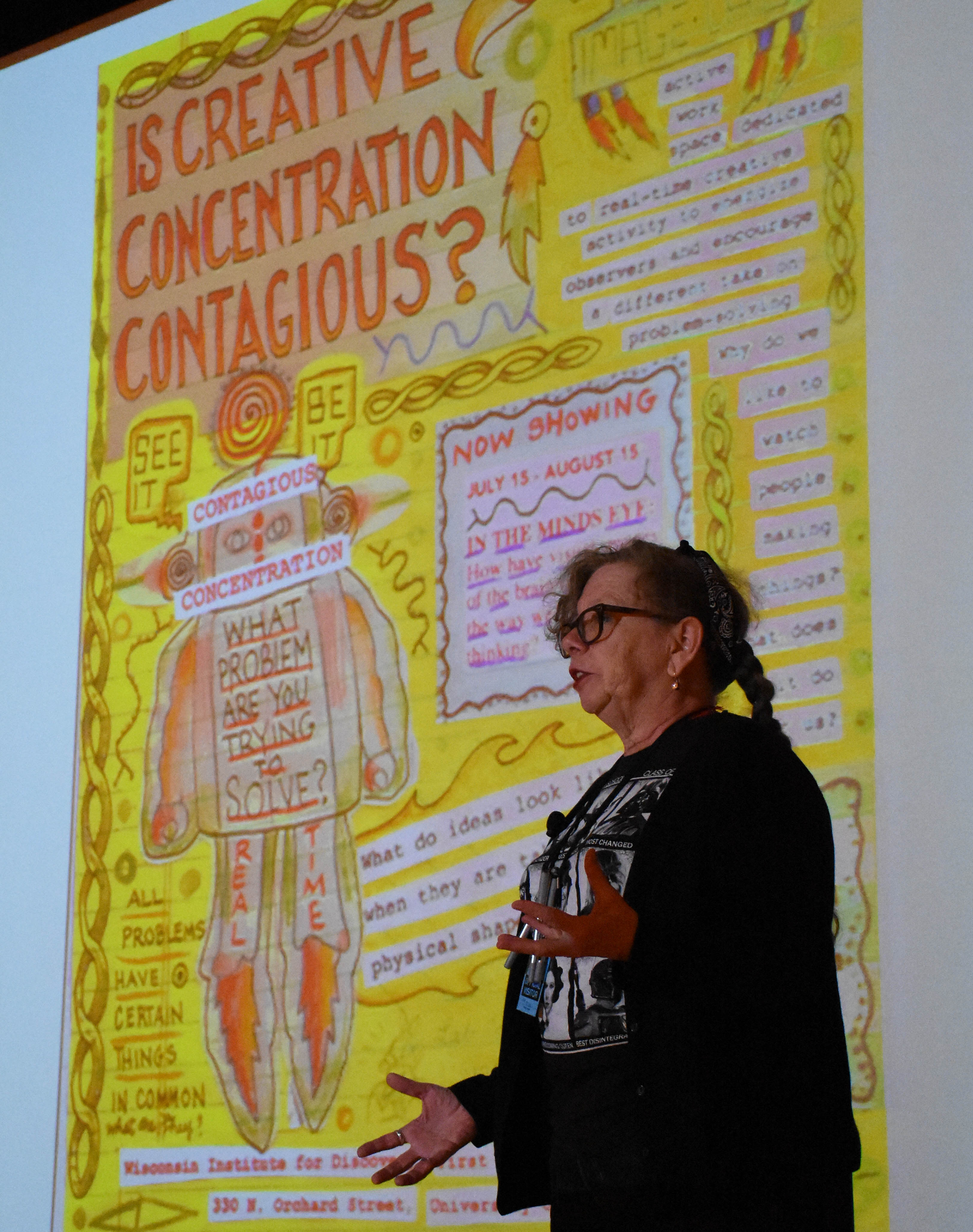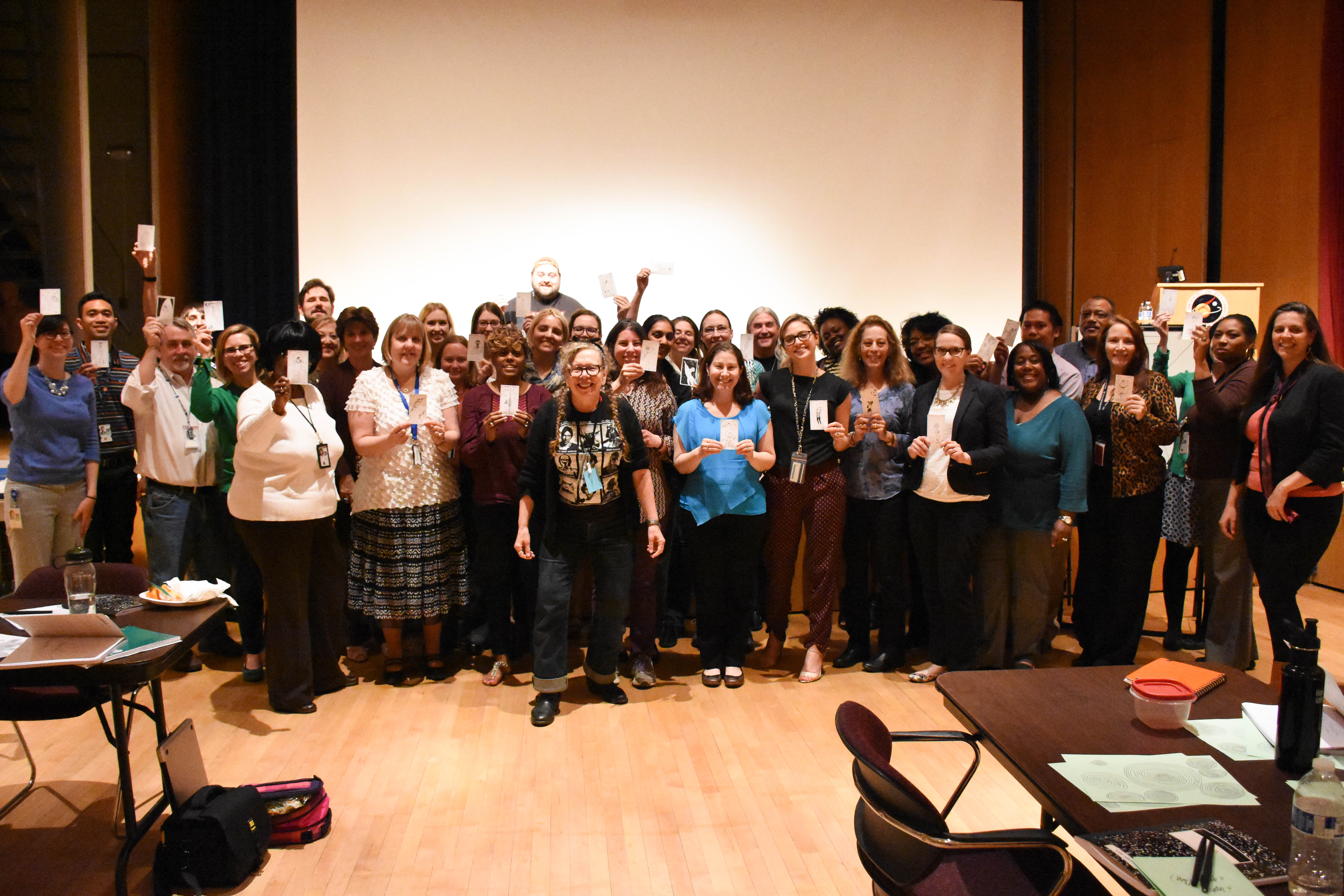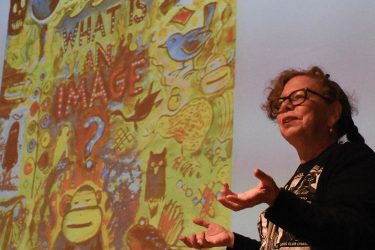Image credit: NASA/Goddard/Rebecca Roth
Lynda Barry notices things. She notices the way your face changes when you are remembering your first crush or first car, she notices what your hands are doing when you think, and she notices the barriers that come between people and the creative expression of their ideas.

In April, when Barry arrived at NASA’s Goddard Space Flight Center just down the road from the University of Maryland, she noticed a lot: the intact 1959-style architecture and decor, beautiful images of nebulae taken by the Hubble Space Telescope (later she noticed the purple Crab Nebula image posted online by NASA in honor of Prince), and even how one employee had replaced her nameplate image with a photo of her dog, complete with a dog treat taped to the wall below.
Barry, clad in her best Star Wars tee-shirt and with dozens of drawings in tow, also noticed that the community of scientists and communicators at NASA was eager to hear her perspectives on creativity and to participate in her workshop, “Writing the Unthinkable”.
As many of her audiences have discovered, Barry is an enchanting speaker and teacher. A few hours spent with her will find you weaving between art, memories, humor, science, reflection, invention, and awe. “I like to incorporate drawing and writing, especially for people who have completely given up on drawing and are totally freaked out,” says Barry. “So I show them pretty quickly that there’s another kind of drawing that isn’t representational drawing, it’s cartooning – it’s comics.”
One of Barry’s favorite moments is the reintroduction of what she calls the original digital devices: the hands. “People think they understand what their hands can do, but there is a different way of thinking that goes along with them; they’re a spontaneous organizing force.
“If you write by hand, something different happens.”
“What I end up showing people is that there is a different idea about where writing comes from. There’s always the hard, difficult place that they come from: you sit there and you type the first four lines over and over again. If you write by hand, something different happens.”
As an assistant professor of interdisciplinary creativity and Discovery Fellow at the Wisconsin Institute for Discovery, Barry has created the Image Lab, a flexible classroom space “dedicated to real-time creative activity, to help encourage a different take on problem-solving.” She is a sought-after visiting artist and speaker, has taught workshops across the country, and has worked with everyone from young children and parents to college classes to prison inmates to world-class scientists. But there’s always a new adventure; this spring, the adventure was NASA.
Mark Hess is the Chief of the Office of Communications at NASA’s Goddard Space Flight Center. He and his communications group have to be experts in everything from human spaceflight to aeronautics and astrophysics. “We touch everything that NASA does from a science point of view,” says Hess. Communicating about such a breadth of subjects through a diverse array of channels presents unique challenges that require not only broad knowledge and skills, but also a creative touch.

“We have all of these subjects which, from one moment to the next, we need to be experts in,” says Goddard web editor Rob Garner. “We’re exposed to a lot of different sciences, discoveries, and engineering feats here, and apart from being incredibly well-versed in all of those areas, our communications team has to be well-versed in the mechanisms of telling other people about all that.”
To bring out the best in his team and augment their own expertise, Hess and his colleagues began bringing in authorities in various forms of communication – writers, photographers, authors, and the like – to share their wisdom and advice in a series of seminars called Story Labs.
Last March, Hess heard Lynda Barry speaking about her work on a podcast called Bullseye with Jesse Thorn, and immediately knew they had to invite her to do a Story Lab. “I was so captured with her; just the energy that she brought to the interview, talking about how the techniques that she employs work as well with kindergartners as with PhD students – it was just infectious,” says Hess. “I came back to work and said, ‘I think I’m just going to quit right now and enroll at UW-Madison because I want to take her class. We need to find out if we can get Lynda to come and talk to our group.’”
For Barry, it was the invitation of a lifetime. “I’ve been in love with space and NASA since I was a little kid. The space age was a big part of growing up,” she says. “It was just an honor to be asked. I couldn’t believe it. I get asked a lot of places, but this was really something.” So of course, she could not pass up the opportunity.
“The phone gives us a lot but it takes away three key elements of discovery: loneliness, uncertainty and boredom. Those have always been where creative ideas come from.”
Her visit included a lecture open to the entire Goddard campus followed by a smaller three-hour writing workshop for the communications team. Later, a viewing of the under-construction James Webb Space Telescope, was a highlight for Barry. “Because everything they’re doing is one of a kind, it looks like a mad scientist’s lab,” she says. “You’d think it would be like a surgery room, but it looks crazy and creative, like an inventor’s space.”
Barry’s impact on the assembled Goddard employees was immediate; from the moment she arrived, she insisted on abandoning all electronic devices. “They were really flipped out about it,” says Barry. “The phone gives us a lot but it takes away three key elements of discovery: loneliness, uncertainty and boredom. Those have always been where creative ideas come from.”
Free from distractions, imagination flowed free throughout the workshop. “When everyone was finally ready to write, they were able to write these complete, really strong stories in a just a few minutes,” says Barry. “I loved listening to them – they were really good writers, and their stories and drawings were so warmly received by their colleagues. The delete button [on the computer] makes it so that anything you’re unsure of you can get rid of, so nothing new has a chance. Writing by hand is a revelation for people. Maybe that’s why they asked me to NASA – I still know how to use my hands.”
Getting back to employing hands in creative work was just one of many of the day’s lessons. “Story Labs give us insight into different storytelling techniques and different ways of looking at our content,” says Rob Garner. “With Lynda, each little piece of the activities we did helped me think about how I tell stories and how I can do that differently… I’ve been at Goddard for nine years, and this has certainly been my favorite [Story Lab].”

One more thing Lynda Barry has noticed: the relationship between science and art is stronger than ever. She was astounded and delighted that people at NASA thought a cartoonist would be a worthwhile guest. “For me science has always been the thing that’s helped me understand art. It gives me the metaphors I need to understand art.”
Back in Madison, still dreaming of the stars, Barry loves to wander past the labs at the Wisconsin Institute for Discovery and gaze at the formulae written on the walls and windows by scientists who are unaware that their equations are art. “They’re as pleasurable to look at as kids’ drawings. What they don’t know is that if they can draw Pi and they can draw all these shapes, they can draw amazing characters.” But Lynda Barry notices, and she is always happy to point it out to us.
— Nolan Lendved
Read NASA’s feature about Barry’s visit and view photos from the day.
Check out Lynda Barry’s blog post where she shows off some of her students’ space-themed drawings.


You must be logged in to post a comment.